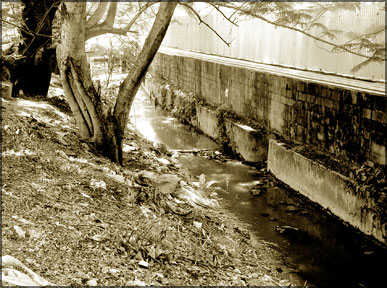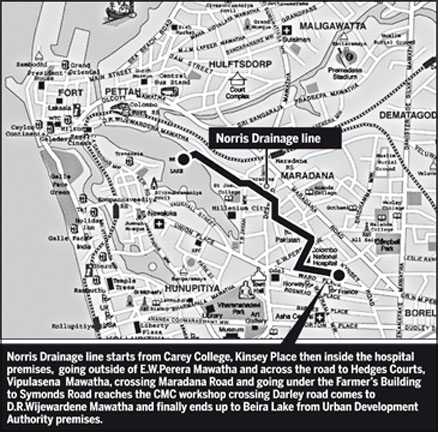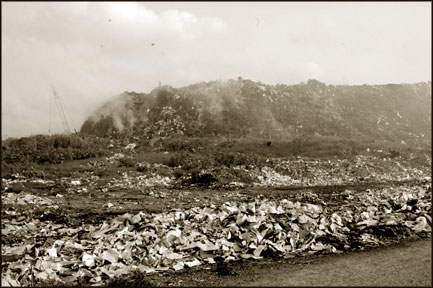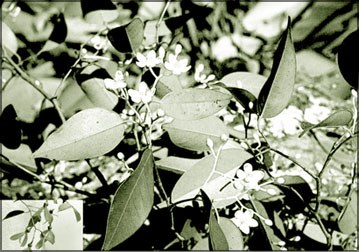[Earth Hope]
Norris Canal turns into garbage sewer
CMC Funds not enough for man or machine:
Harshini PERERA
 |
|
Norris Canal |
How would you feel if you had to enter to your workplace passing by a
stinking drainage canal? You would resent that idea, no doubt, if you
personally experience it.
Yes, it is no wonder for state as well as and private sector
employees whose work places are located closer to the Norris Canal,
which runs along the D.R. Wijewardena Mawatha, near the Gamini Hall
roundabout.
The canal is in good order but sadly lacks maintenance. The drain is
a cozy place for flies and mosquitoes, the sponsors of dengue and
Chikungunya.
The Norris Canal which was built to drain off storm water, originates
near Carey College, Colombo, carries a way not only rain water to the
Beira Lake but also polluted waste water from the General Hospital and
the vicinity.
Moreover people have turned it into a garbage dump which makes the
situation worse. People who work in state and private establishments, as
well as the residents living around the area are the ones who are badly
affected.
Other than the stench, the area is swarmed with mosquitoes, making it
difficult for anyone to do even a bit of work even during daytime.
The area near the roundabout is full of important buildings like the
National Chamber of Commerce, Ministry of Transport, Samagam Medura
which draw visitors including foreign delegates and ministers, almost
daily.
“This has been a major problem for the past eight years since the
time the canal was last cleaned. We have been nauseated by the stench,
in addition to the nagging mosquitoes, irritating flies and crawling
cockroaches.
On top of all this, piles of lamp posts belonging to CEB, have been
stacked on the wayside, providing a good cover for nefarious
activities,” said, Athula, an owner of a bookshop just across the road.
The Finance Manager of the National Chamber of Commerce had made
several complaints to the Colombo Municipal Council but the stock
response he got was shortage of funds.
“We cannot work peacefully while being bitten by mosquitoes all the
time. Even the fans or the mosquito coils can deter the mosquitoes”, a
security guard lamented.
 “The canal starting near Carey College and runs close to the Colombo
National Hospital, where waste water and garbage from the hospital gets
into the canal. Moreover, people use the canal for their ablutions as
well.” a three-wheeler driver who operates near the area for the past 10
years, told the Sunday Observer. “The canal starting near Carey College and runs close to the Colombo
National Hospital, where waste water and garbage from the hospital gets
into the canal. Moreover, people use the canal for their ablutions as
well.” a three-wheeler driver who operates near the area for the past 10
years, told the Sunday Observer.
“Although the rain water flushed out the garbage, the stench
remains,” said an employees attached to the Chamber of Commerce.
The canal is maintained by the 2B Engineering Division of Colombo
Municipal Council.
When contacted, Maintenance Engineer, W.M.U.K. Kumara of 2B division,
explained that a massive project was planned, so long ago but the funds
were not forthcoming.
“The location also makes it difficult to clean the canal bed using
backhoe loaders,” he pointed out.
An official from Colombo Municipal Council on condition of anonymity
said that the staff are not only inefficient but also insufficient
making things more complicated while the short allocation of funds makes
things more difficult.
It is apparent that the General Hospital is the main polluter of this
canal.
He further said that it was by no means a small project where it had
to be restructured right from the Beira lake .
In other words the whole system of drainage should be reconstructed
which may cost a tidy sum. People should be made aware that this rain
water drainage system should not be polluted with sewage water or
washwater, because it will affect the ecological balance of Beira lake.
Proper waste management - a must
At a discussion held recently at the Temple Trees presided by
President Mahinda Rajapaksa - with the representation of the Ministries
of Urban Development and Sacred Area Development, Local Government and
Provincial Councils, Board of Investments and Colombo Municipal Council
- about the environmental, health and safety issues that arose
concerning the Bloemendhal garbage dump, Patalee Champika Ranawaka,
Minister of Environment and Natural Resources pointed out that although
a National Programm for garbage disposal have been formulated - Pilisaru
- and already in practice the total authority of garbage disposal lies
with local authorities.
 |
|
Bloemendhal garbage
dump |
Since these local authorities are working with private companies on
long term contracts taking necessary action concerning garbage disposal
has proved difficult.
The garbage problem in Colombo has taken a turn for the worse because
garbage from Panadura, Gampaha, Avissawella, Maharagama and Kaduwela are
brought to the city of Colombo by private companies.
He also pointed out that fact that land had not been allocated for
garbage disposal when planing settlements, towns, industries and free
trade zones and using the land allocated to garbage disposal for other
purposes is another reason for the issue.
Since no proper garbage segregation methods are adhered to waste from
all sorts of industries such as hospital, harbour and electronic are
dumped haphazardly in one dumping site.
Consequently President Mahinda Rajapaksa said that garbage disposal
should be conducted according to Pilisaru with the collaboration of the
Ministry of Environment and Natural Resources, Local government,
Ministry of Local Government and Provincial Councils, Urban Development
Council.
He said that necessary legal action would be taken against those who
attempt to turn garbage disposal into a money making scheme.
He called for immediate action by the Urban Development Council to
identify and to obtain suitable land for garbage disposal. Land should
be used for garbage disposal under the Pilisaru programme. Garbage dumps
that pose a threat, such as Bloemendhal, Karadiyana and Kandy Gohagoda
should be dealt with by formulating necessary legal plans against
current garbage disposal practices. He also recommended the that
segregation of electronic, plastic, polythene should be facilitated
further.
It was revealed that there are eleven urban and provincial councils
whose haphazard waste management processes have posed a threat to human
hygiene, safety and environment and taking due legal action will soon
ensue.
Climate Trail
Climate Trail exhibition which is now on at the Public Library
premises will end on March 17.
The exhibition is organised by the Ministry of Environment and
Natural Resources together with the Embassy of Switzerland in Sri Lanka.
Her Excellency the Ambassador of Switzerland Ruth Flint and Patali
Champika Ranawaka, Minister of Environment and Natural Resources graced
the occasion.
 Owing to the fruitful cooperation between the Ministry of Environment
and Natural Resources and the Embassy of Switzerland in Sri Lanka, the
Sri Lankan public has the opportunity to enjoy this enriching outdoor
experience in March 2009. Owing to the fruitful cooperation between the Ministry of Environment
and Natural Resources and the Embassy of Switzerland in Sri Lanka, the
Sri Lankan public has the opportunity to enjoy this enriching outdoor
experience in March 2009.
For a long time already Switzerland has been well aware of the
consequences of global warming and the response that this challenge
demands. For instance, Swiss glaciers are melting at an unprecedented
pace, skiing may soon be history in some mountain resorts, there are
more and stronger thunderstorms and flooding becoming more frequent.
For this reason, government agencies, business leaders as well as
leading scientists in Switzerland have been working together to find
innovative solutions to reduce energy consumption and foster sustainable
ways of living.
The Climate Trail exhibition is way of sharing their experiences with
Switzerland’s partners in the world. It consists of a series of posters
and experts’ comments on issues related to climate change. It offers an
interactive opportunity to learn about global warming and encourages
multidisciplinary discussions about how to pursue a more sustainable
lifestyle.
The Climate Trail exhibition describes the greenhouse effect and
other contributors to global warming, details its impact and offers
solutions, some of which already adopted by Switzerland in recent
decades, including transportation initiatives, low-carbon-footprint
construction, renewable energy and strategies for sustainable living.
The exhibition is a unique opportunity to learn about climate change,
science and solutions. In the United States of America where the
Exhibition is a great success, thousands of people have already walked
and enjoyed the Climate Trail Exhibition and enhanced their knowledge on
one of the most important issues of our time.
Smallest Whale Shark discovered
Early on March 7 a project leader from the international conservation
organization WWF and others in the town of Donsol, San Antonio,
Philippines, heard that a live whale shark was being offered for sale at
a nearby beach. Expecting a stranded giant, the rescuers found instead a
15-inch (38-centimeter) shark leashed to a stake in the mud like a
neglected puppy.
Harmless to humans, whale sharks feed mainly on plankton and can grow
to at least 40 feet (12 meters) long. They are listed as vulnerable by
the IUCN, meaning they "face a high risk of extinction in the
medium-term future."
Source: nationalgeographic.com
Extinct?
 Doona ovalifolia (Piniberiliya) Doona ovalifolia (Piniberiliya)
Family - Dipterocarpaceae
Scientific Name - Doona ovalifolia Thw.
Sinhala Name - Piniberiliya
Status - Extinct, Endemic
Doona ovalifolia belongs to the Dipterocarpaceae family (Hora), which
consists of fifty eight endemic species. Genus Doona consists ten
species. Among them D. ovalifolia is only recorded from the Hewesse area
(Nellowe), never recorded after 1928. Only one tree found is found,
today in the Royal Botanical Garden, Peradeniya.
Large sized tree is 16-18m tall and bole short with superficially
narrowly fluted. Bark of the tree has dark brown and peels in large
thick plates.
Branchlets are slender, glabrous. Terminal buds are small with few
bud scales. Stipules are oblong. The indicative features are ovate
leaves and secondary veins visible on the underside of leaf. Flowering
occurs as small white flowers in top of the branches. Small fruits have
three broad wings with a narrow base.
According to the 2007 Red List of Threatened Fauna and Flora of Sri
Lanka Piniberaliya is an extinct species, the main reason for which is
destructive agricultural practices (clearing for major crops), habitat
destruction, etc...
Reference
1. Kostermans, A.J.G.H. (1992) A handbook of the Dipterocarpaceae of
Sri Lanka. Wildlife Heritage Trust of Sri Lanka.
2. UCN Sri Lanka and the Ministry of Environment and Natural
Resources (2007). The 2007 Red List of Threatened Fauna and Flora of Sri
Lanka, Colombo, Sri Lanka.
Pic source: Kostermans, 1992
Dilup Chandranimal
IUCN (The International Union for Conservation of Nature)
Sri Lanka - Country Office |


